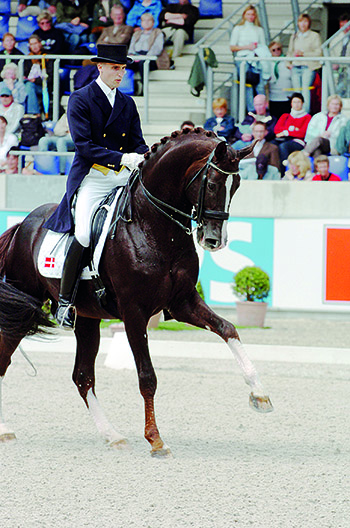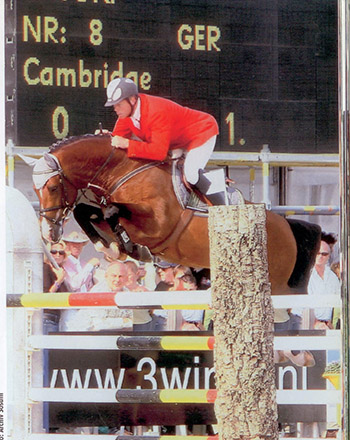The picture in 2007
What are the German breeding values? There are actually two sets of numbers involved…
The German FN publishes its FN rankings based on the BLUP animal model. It takes into account the results of the stallion’s performance test, the mare performance test, the results in young horse classes and competition results. Like the stallion performance tests, the results are standardised to a mean value of 100 points and a standard deviation of 20 points. Breed values of under 100 points represent a negative, those over 100 points a positive deviation from the mean.
The Hanoverian Verband in its Hannoveraner Jahrbuch Hengste, published since 1999, produces its own stallion rankings, based on the results of the mare tests and the auction evaluations.
The FN standings are heavily influenced by the stallion’s own competition results, which are not taken into account in the Hanoverian rankings. Having said all that, the two ranking systems produce remarkably similar results each year.
The Hanoverian rankings also give a detailed breakdown of values for type and paces. For example, Stakkato’s progeny achieve the very high rating of 166 for their jumping ability and 93 for their dressage. In keeping with Dr Bade’s worries about type, his offspring have a poor rating for their conformation. Stakkato scores a negative 75 for type (the highest ranking for type has gone every year since the yearbook first appeared to the Trakehner, Caprimond. In the 2008 book, Caprimond’s index for type is 148).
However, even the chief mover and shaker behind the Hanoverian Stallion Book, Verband administrator, Ludwig Christmann warns that the rankings should not be accepted uncritically: “The breed value estimation is not some genius idea that solves the breeder’s every problem – rather it is a ‘brain twister’; it presents the breeder with the range of information that should be taken into account before making a considered decision. One should definitely avoid to any tendency to randomly breed by numbers!”
The question of ‘breeding by numbers’ has been hotly debated in most breeding countries – it appears to have been most influential in France where the BLUP ratings played a huge role in the direction of breeding. In Germany the values seem to have had less influence.
The FN’s rankings, the estimation of Breeding Values (EBVs) started in 1991 with the German FN’s Jahrbuch Zucht 1990. They were initially published in three different age groups. In the Jahrbuch Zucht 1999 the FN started to publish the TOP-Rankings for both disciplines: dressage and jumping.
It is interesting to note that the stallions that have consistently attracted the most mares in recent years, have been stallions too young to even have an FN rating, something that obviously hasn’t bothered German mare owners.
A similar situation exists in Holland, where despite the fact that stallion indexes have been published for nearly 30 years, there is no apparent relationship between a high index and the number of mares coming to the stallion. In an article ‘More than just for appearance sake – or the other way round’, in the February 2003 edition of Z Magazine, Henk Bouwman compares the ratio of service to the breeding values of the KWPN sires for 2001, and finds that 15 of the 22 most popular sires have no breeding value at all. In that year the most popular stallion was Indoctro with 396 mares, and a breeding value of 133, which put him into 16th place – while Concorde, who enjoyed a breeding value of 166, attracted only 150 mares…
An examination of the rankings issued by the FN for 2007, does raise a few questions about just what it is they are measuring.
Don Schufro once again heads the dressage list – and while Don Schufro is indeed a wonderful competitor and comes from a hugely successful ‘family’, this ranking would appear to be largely on the basis of his own competition performance (and that of his relatives) rather than any proven ability to produce dressage horses. His son, Diamond Hit competes at Grand Prix level with Emma Hindle, after good performances at the Bundeschampionate and a Reserve Championship in the five year old class at the World Young Dressage Horse championships. He has sired six licensed sons, and a mare who was the Champion at the Danish Elite Broodmare Show…
Second place goes to Breitling W – again a solid performer in his own right, and sire of some interesting horses at the Bundeschampionate… but second best dressage sire in Germany? Then there is the Trakehner, Münchhausen, another lovely horse, and a useful Grand Prix performer after starring in young horse classes. At least with Münchhausen we have a horse that has produced 177 competition horses, 59 of whom have placed, winning 551 ribbons, with three of his progeny competing at an advanced level. In fourth place we have His Highness who sadly died in 2007.
Let me declare my interest: I know Highness’s American owners, Doug and Louise Leatherdale, and like them, they are astute breeders with a good eye; the stallion stood with Jens Meyer, who I count as one of my closest friends. I have also used Highness semen in my breeding program. I very much hope that in a few years time, we will see what a great dressage stallion the handsome black horse would have made, had he lived, but how on earth can a stallion, who has produced 60 registered competition horses for total winnings of €2500 be ranked the fourth best dressage sire in Germany??? I don’t think even my friend Jens – certainly not before midnight anyway – would suggest that His Highness is established as a better sire than Donnerhall (who ranks 29th), or Fidermark (31st) or Weltmeyer (32nd). Just what is it that these ‘numbers’ are measuring?
It is all through the list, young stallions with scarcely a competitor to represent them in the sport, receive higher rankings than the stallions who have consistently produced winning progeny at all levels. Thus Samba Hit I makes it to the top 38 (in 9th) but not his dad, Sandro Hit, Florencio is 5th but no Florestan, Weltano and Wild Dance but no Wolkenstein II and two sons of Hohenstein (Münchhausen 3rd and His Highness 4th) but no Hohenstein…
Even in the jumping standings, which are usually a little more understandable, there are some weird ones. Stakkato is number one, but how on earth is it that the eight year old Catoki whose claim to performance fame consists of some good Bundeschampionate performances and a win at the Rastede Grand Prix, and whose output to date consists of some promising foals and two licensed stallions, rate above Carthago, Clinton, Indoctro and Cassini??
My good friend Ludwig Christmann – who was kind enough to read this work in manuscript – gently took me to task for my breeding values ‘polemic’. He points out that “when His Highness has a few more points in the evaluation than Donnerhall, then you cannot say that automatically one is a better sire than the other one. Both stallions have breeding values in the FN rating of more than 150 points. This means, that they are more than two and a half standard deviations above average, which groups them probably in the top 2/3% of our stallions. And there is an evaluation of the characteristics that make up this evaluation – in both our Hanoverian breeding evaluation, and in the FN’s Jahrbuch Zucht, you can find detailed evaluations of head, neck, frame and so, as well as individual scores for walk, trot and canter. So the breeder can find objective information which would help him to find the stallion that best matches his mare. Especially in times when many breeders rely on glossy coloured photos and videos composed by the stallion owner, the breeding evaluations are an important tool for the mare owner. That does not mean that the system is perfect, but we are able to improve this system by publishing the breeding values. This is the best way to find the weak spots.”
“You also mentioned Catoki and this is another good example. He is well bred, he has been very successful with his own performances and his first offspring were outstanding… So he deserves a high breeding value. Because the evaluation is based on a limited number of offspring, the breeder can see that the reliability of this value is not high, which indicates that this may change in the future, but it is a hint to the breeder: Here is a young stallion which deserves further attention.”
But the FN is not alone in producing these sorts of results. The 2008 Hanoverian jumping rankings show Contendro in first place, with Fly High, second, in front of established performers and sires, like Stakkato, Adlantus As, Calido, and Fly High’s great sire, For Pleasure. Fly High’s claim to fame consists of two wins at advanced level for €8,009 in prizemoney – and 54 registered competitors, nine of whom have placed 124 times, with winnings of €6,077, none of whom have placed at Advanced level. Fly High’s sire, For Pleasure, despite concentrating on a competition career that has seen personal winnings of €1,843,652, has still managed to produce 198 competitors with €1,100,223 in winnings.
Numbers!
Writing on the 2007 WBFSH Congress in the December 2007/January 2008 edition of Z Magazine, the thoughtful German journalist, Jörg Savelsberg gently pointed out: “Breeding value indexes are common in animal breeding, and expedient when it is about precisely defined criteria. If a bull’s daughter produces x litres of milk annually this a criterion which makes it possible to compare the bull with other bulls. But in horse breeding things are different. What does a breeding value of 150 say about a sire? That his offspring are careful? That they have much power? That they are willing to work and ‘rittig’ (are pleasant to ride), that the sire is suitable for heavy mares, that his impregnation rate is high? No, it does not. As they say in Germany, the breeding value should only be a piece of the puzzle for a breeder who has to decide on which stallion to use. By why would one want to compare pieces of a puzzle that show no conclusions of fundamental individual characteristics?”


